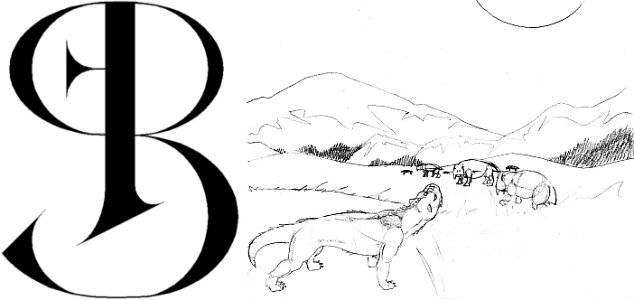 Gryphons are one of the first intelligent species we invented for the Squawk Role-Playing Game, but they have settled on their current form only recently. This drawing is a slightly modified version of the original and totally awesome design by my brother Ulrich.
Gryphons are one of the first intelligent species we invented for the Squawk Role-Playing Game, but they have settled on their current form only recently. This drawing is a slightly modified version of the original and totally awesome design by my brother Ulrich.The bird-like appearance is superficial: Gryphons and Gargoyles belong to a fictional group of archosaurs resembling crocodiles with long, flexible, otter-like bodies. (Also in this fictional family are the snake-like guivres.) While Gargoyles became stealthier with naked, color-changing skin, Gryphons became large, powerful, tiger-like predators with huge claws. At some point the Gryphon ancestors aquired insulating pseudo-feathers similar to dinosaurs and pterosaurs, and lost their teeth, so Gryphons rip at their prey with sharp beaks.
 Gryphons are extraordinarily flexible, moving like a cross between a cat and a snake. All of their joints have a wide range of motion. They can curl up into a ball and wrap around trees. This flexibility helps them to climb, move through tight spaces and crawl through tall ground cover when stalking prey.
Gryphons are extraordinarily flexible, moving like a cross between a cat and a snake. All of their joints have a wide range of motion. They can curl up into a ball and wrap around trees. This flexibility helps them to climb, move through tight spaces and crawl through tall ground cover when stalking prey. At one point gryphons were becoming a less flexible dinosaur design related to archaeopteryx and sickle-clawed dromaeosaurs. In this drawing we can see a combination of archaeopteryx, feathering, anthropomorphic torso and sickle-clawed feet. (It looks like I left an extra toe on one of the feet.) This is totally unlike the current Gryphon idea.
At one point gryphons were becoming a less flexible dinosaur design related to archaeopteryx and sickle-clawed dromaeosaurs. In this drawing we can see a combination of archaeopteryx, feathering, anthropomorphic torso and sickle-clawed feet. (It looks like I left an extra toe on one of the feet.) This is totally unlike the current Gryphon idea. Here is an effort to rehabilitate the same drawing as a modern gryphon with a toothless beak and four huge talons on each foot. The tail, with it's archaeopteryx-like feather pattern, will probably have to go.
Here is an effort to rehabilitate the same drawing as a modern gryphon with a toothless beak and four huge talons on each foot. The tail, with it's archaeopteryx-like feather pattern, will probably have to go.







